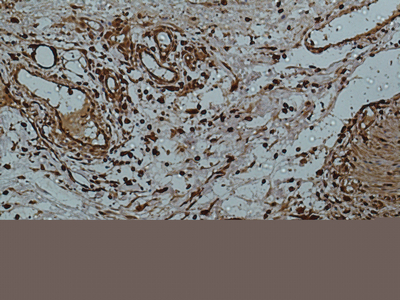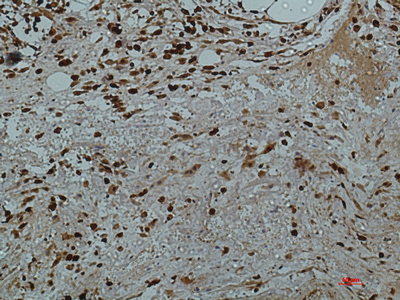Galectin-3 Monoclonal Antibody(8D7)
- Catalog No.:YM3532
- Applications:WB;IHC;IF;ELISA
- Reactivity:Human;Mouse
- Target:
- Galectin-3
- Gene Name:
- LGALS3
- Protein Name:
- Galectin-3 (Gal-3) (35 kDa lectin) (Carbohydrate-binding protein 35) (CBP 35) (Galactose-specific lectin 3) (Galactoside-binding protein) (GALBP) (IgE-binding protein) (L-31) (Laminin-binding protein)
- Human Gene Id:
- 3958
- Human Swiss Prot No:
- P17931
- Mouse Swiss Prot No:
- P16110
- Immunogen:
- Protein
- Specificity:
- Galectin-3 protein detects endogenous levels of Galectin-3
- Formulation:
- Liquid in PBS containing 50% glycerol, 0.5% BSA and 0.02% sodium azide.
- Source:
- Monoclonal, Mouse
- Dilution:
- WB 1:2000-5000, IHC 1:100-200. IF 1:50-200
- Purification:
- The antibody was affinity-purified from mouse ascites by affinity-chromatography using specific immunogen.
- Concentration:
- 1 mg/ml
- Storage Stability:
- -15°C to -25°C/1 year(Do not lower than -25°C)
- Other Name:
- LGALS3;MAC2;Galectin-3;Gal-3;35 kDa lectin;Carbohydrate-binding protein 35;CBP 35;Galactose-specific lectin 3;Galactoside-binding protein;GALBP;IgE-binding protein;L-31;Laminin-binding protein;Lectin L-29;Mac-2 antigen
- Observed Band(KD):
- 26kD
- Background:
- This gene encodes a member of the galectin family of carbohydrate binding proteins. Members of this protein family have an affinity for beta-galactosides. The encoded protein is characterized by an N-terminal proline-rich tandem repeat domain and a single C-terminal carbohydrate recognition domain. This protein can self-associate through the N-terminal domain allowing it to bind to multivalent saccharide ligands. This protein localizes to the extracellular matrix, the cytoplasm and the nucleus. This protein plays a role in numerous cellular functions including apoptosis, innate immunity, cell adhesion and T-cell regulation. The protein exhibits antimicrobial activity against bacteria and fungi. Alternate splicing results in multiple transcript variants.[provided by RefSeq, Oct 2014],
- Function:
- function:Galactose-specific lectin which binds IgE. May mediate with the alpha-3, beta-1 integrin the stimulation by CSPG4 of endothelial cells migration. Together with DMBT1, required for terminal differentiation of columnar epithelial cells during early embryogenesis.,online information:Galectin-3,similarity:Contains 1 galectin domain.,subcellular location:Cytoplasmic in adenomas and carcinomas. May be secreted by a non-classical secretory pathway and associate with the cell surface.,subunit:Probably forms homo- or heterodimers. Interacts with DMBT1 (By similarity). Forms a complex with the ITGA3, ITGB1 and CSPG4. Interacts with LGALS3BP, LYPD3, CYHR1 and UACA.,tissue specificity:A major expression is found in the colonic epithelium. It is also abundant in the activated macrophages.,
- Subcellular Location:
- Cytoplasm . Nucleus. Secreted . Secreted by a non-classical secretory pathway and associates with the cell surface. Can be secreted; the secretion is dependent on protein unfolding and facilitated by the cargo receptor TMED10; it results in protein translocation from the cytoplasm into the ERGIC (endoplasmic reticulum-Golgi intermediate compartment) followed by vesicle entry and secretion (PubMed:32272059). .
- Expression:
- A major expression is found in the colonic epithelium. It is also abundant in the activated macrophages. Expressed in fetal membranes.
- June 19-2018
- WESTERN IMMUNOBLOTTING PROTOCOL
- June 19-2018
- IMMUNOHISTOCHEMISTRY-PARAFFIN PROTOCOL
- June 19-2018
- IMMUNOFLUORESCENCE PROTOCOL
- September 08-2020
- FLOW-CYTOMEYRT-PROTOCOL
- May 20-2022
- Cell-Based ELISA│解您多样本WB检测之困扰
- July 13-2018
- CELL-BASED-ELISA-PROTOCOL-FOR-ACETYL-PROTEIN
- July 13-2018
- CELL-BASED-ELISA-PROTOCOL-FOR-PHOSPHO-PROTEIN
- July 13-2018
- Antibody-FAQs
- Products Images

- Western blot analysis of 1)MCF7, 2) 3T3 with Galectin-3 Mouse mAb diluted at 1:2,000.

- Immunohistochemical analysis of paraffin-embedded human-colon using antibody diluted at 1:50.

- Immunohistochemical analysis of paraffin-embedded human-colon2 using antibody diluted at 1:50.



